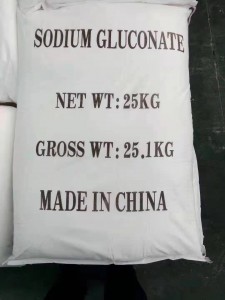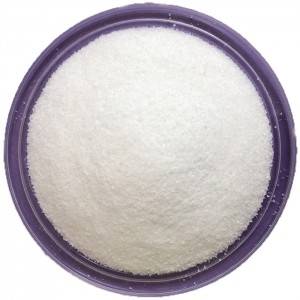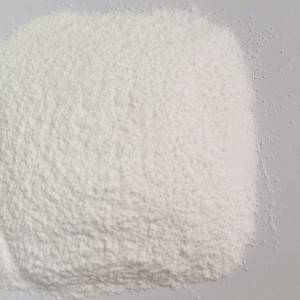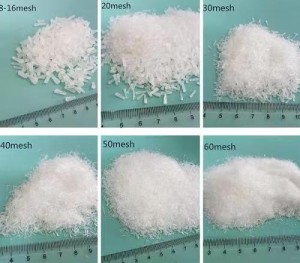Sodium gluconate is an organic substance with a chemical formula of C6H11NaO7. It has a wide range of industrial uses. Sodium gluconate can be used as a high-efficiency chelating agent in construction, textile printing and dyeing, metal surface treatment and water treatment industries, steel surface cleaning agent, glass bottle cleaning It can be used as a high-efficiency retarder and high-efficiency water reducing agent in the concrete industry.
Sodium gluconate specification:
|
Ca(C6H11O7)2 |
98.0~102.0% |
|
Loss on drying |
0.3 % Max |
|
PH value |
6.2-7.8 |
|
Heavy metal (mg/kg) |
20 Max |
|
Arsenic (mg/kg) |
3 Max |
|
Reducing sugar |
0.5% Max |

Used as a cleaning agent for steel surface:
If the steel surface needs to be plated, chrome-plated, tin-plated, nickel-plated for special purposes, such as the manufacture of tinplate, galvanized sheet, surface chromium plating (electricity), etc., the surface of the billet must be strictly cleaned to make the coating and steel The surface is firmly bonded. At this time, adding sodium gluconate to the cleaning agent will achieve a very ideal effect. This has been confirmed by major international tinplate manufacturers.
Used as cement admixture:
After adding a certain amount of sodium gluconate to cement, it can increase the plasticity and strength of the concrete, and it has a blocking effect.
That is to delay the initial and final setting period of concrete. For example, adding 0.15% of sodium gluconate can prolong the initial setting time of concrete by more than 10 times, which is to extend the plastic time of concrete from a few hours to a few days without affecting it. Fastness. Plasticity and delaying the initial setting time are very important issues in concrete operations. For example, in high-temperature season construction and large-scale engineering operations, delaying the initial setting time is a problem. Sodium gluconate can solve this problem satisfactorily. In addition, it is more difficult to glue oil wells at high temperatures. The concrete added with sodium gluconate can be plasticized within a few hours at a high temperature of 170°C, so the above problems can also be satisfactorily solved. Therefore, sodium gluconate as a cement admixture has been widely used in important construction projects abroad, such as a large number of bridge projects in the Middle East. However, the application in this area in our country has not been promoted. It is said that sodium cellulose sulfonate is extracted from papermaking wastewater, and its effect is not comparable to that of sodium gluconate.
Sodium gluconate as water reducer
By adding a water reducing agent, the water-cement ratio (W/C) can be reduced. The following effects can be obtained by adding sodium gluconate: 1. Improve workability. When the water-cement ratio (W/C) remains unchanged, adding sodium gluconate can improve workability. At this time, sodium gluconate acts as a plasticizer. When the addition amount of sodium gluconate is below 0.1%, the degree of improvement in workability is proportional to the addition amount. 2. Improve strength. When the cement content remains the same, the water content in the concrete can be reduced (that is, W/C is reduced). When the amount of sodium gluconate added is 0.1%, the amount of water added can be reduced by 10%. 3. Reduce cement content. The water and cement content is reduced in the same proportion, and the W/C ratio remains unchanged.
Sodium gluconate as retarder
Sodium gluconate can significantly delay the setting time of concrete. When the dosage is less than 0.15%, the logarithm of the initial setting time is directly proportional to the dosage, that is, the dosage is doubled, and the initial setting time is delayed to ten times, which makes the working time from very few The hours are extended to several days without compromising strength. This is an important advantage especially in hot weather and when it needs to be placed for a long time.
Used as a special cleaning agent for glass bottles
The beverage industry, food industry, and brewing industry have hundreds of millions of glass bottles per day, such as soda bottles, beer bottles, milk bottles, canned bottles, soy sauce bottles, wine bottles, etc. The cleaning work is a very important thing. The formulation of medicaments is a difficult technical task. An ideal medicine has not yet appeared in China. The main problems are: poor detergency, easy to block the nozzle and pipeline of the bottle washer; unsatisfactory de-staining power to bottle stickers and bottleneck rust; the trace residue after washing is not ideal for food safety (such as phosphate Residue); the washing water is discharged into a public hazard (not meeting the standards set by the country). If sodium gluconate is used as the main body in the formulation of the glass bottle cleaning agent, the above problems can be solved. (In the 1980s, large-scale experiments were carried out at the Shanghai Soda Factory and Shanghai Brewery, and there are identification certificates.) This application has not yet been developed in China. If a market is formed, the potential is great.
Used as water quality stabilizer
Because sodium gluconate has excellent corrosion and scale inhibition effects, it is widely used as a water quality stabilizer, for example, as a treatment agent for circulating cooling water systems in petrochemical enterprises, low-pressure boilers, and cooling water systems for internal combustion engines. Because it has the following special advantages: ⑴ It has obvious coordination effect. It is suitable for formulas such as molybdenum, silicon, phosphorus, tungsten, nitrite, etc. The corrosion inhibition effect is greatly improved due to the coordination effect. ⑵ The corrosion inhibition rate increases with the increase of temperature. Generally, corrosion inhibitors decrease with the increase of temperature, or even lose their effect completely. But sodium gluconate is just the opposite. The corrosion inhibition rate increases with the increase of temperature within a certain range. For example, in the test of carbon steel and other materials, the temperature rises from 77°F to 120°F, and its buffer rate increases by an average of 5%. the above. Therefore, the peculiar characteristics of sodium gluconate are ideal for use as a corrosion inhibitor for higher temperature systems or systems with temperature changes from low to high temperatures. ⑶Strong anti-scaling ability: It has strong complexing ability to calcium, magnesium and iron salts, so it has strong anti-scaling ability, especially for Fe3+, which has excellent chelating effect, even in the whole PH range. ⑷ Eliminate public hazards. Sodium gluconate is used as a corrosion and scale inhibitor for circulating cooling water to eliminate public hazards, which is an incomparable advantage to other corrosion and scale inhibitors used.
Used in medicine
Regulates the acid-base balance in the human body to restore the normal function of the nerves. It can also be used as a food additive for the same purpose.
In addition, it can also be used in electroplating and film manufacturing industries.
As a polyhydroxy carboxylic acid type excellent corrosion and scale inhibitor, sodium gluconate, due to its many specific properties, if it can work hard in application technology, it will definitely be developed into a big industry.








